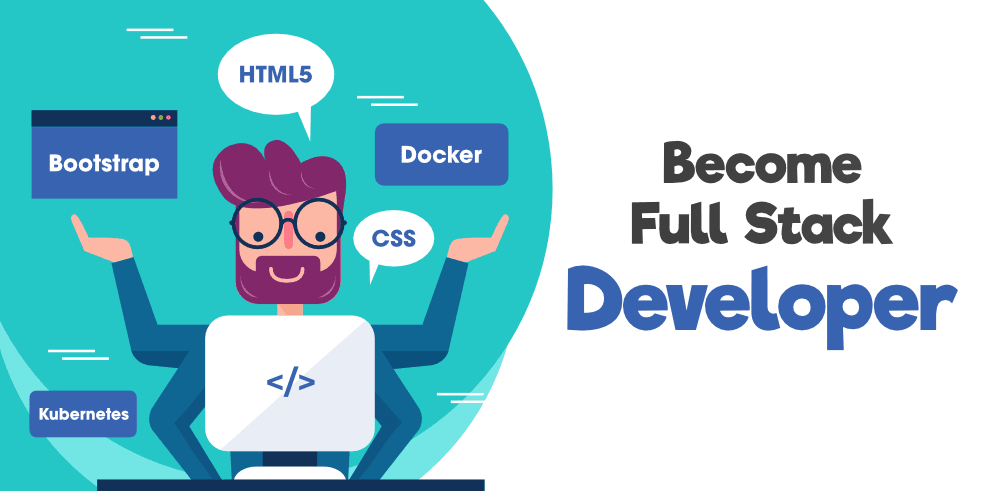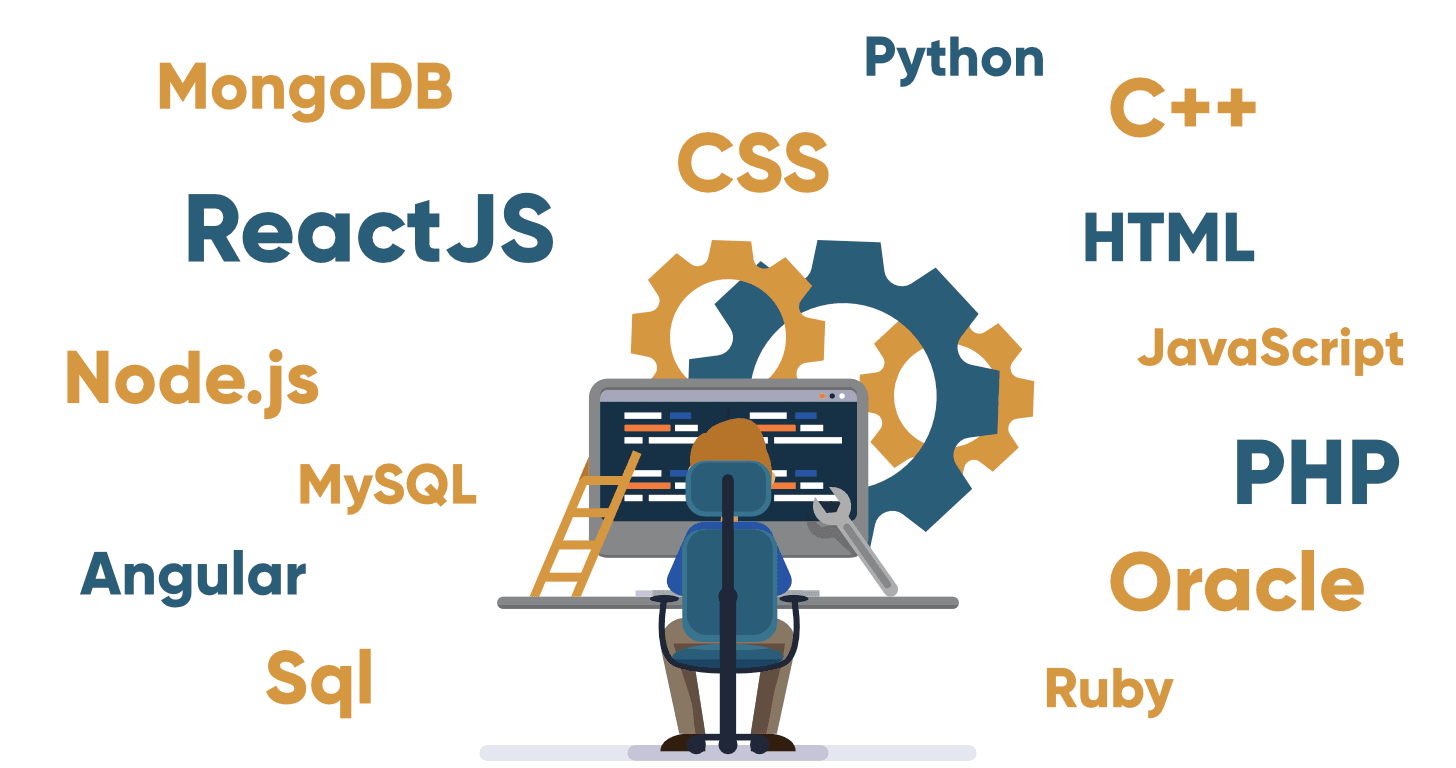The tech market is changing quickly. Therefore, there is a huge need for full stack developers who can take full stack development to a whole new level in this age of advanced technology. This article covers the Full Stack Web Developer Roadmap. From basics to details, we will show you everything you need to start a web development career. Let's begin!
What is A Full-Stack Developer?
A full-stack developer refers to a developer who can develop both the front and back ends of a web application. The front end (the components of a website users view and interact with) and the back end (data storage and processing) require separate skills.
Full-stack developers work on all parts of development, they need to have all app development skills. They know how to use HTML, CSS, JavaScript, and at least one back-end tool, like Ruby on Rails. This is why they're called "full stack": they know how to build web pages, websites, and web apps from start to finish.
A full-stack developer creates a program from scratch. And designing an app's front-end and back-end while assuring efficiency, reliability, and other key aspects.

What Does A Full-Stack Developer Do?
Full-stack developers build multiplatform websites and apps. This position's duties include:
-
Making website back-end apps.
-
Creating effective servers and databases.
-
Mobile phone cross-platform optimization.
-
Maintaining app responsiveness.
-
Working with graphic designers on web features.
-
Bringing a project to completion.
-
API design and development.
As a Full Stack Developer, you will have responsibilities as:
-
Create and take care of computer services and interfaces.
-
Help with the growth of both the front and back ends.
-
Add new tools or APIs to your products.
-
Test software, figure out what's wrong with it, and fix bugs.
-
Work on projects and sprints with people from other areas.
-
Meeting consumer and technical needs.
-
Following web application and programming language improvements.
Many new and growing technologies challenge the limits of full-stack development. This role is intriguing since it requires staying current on full-stack development technologies and methods.
Which Languages Do Full-stack Developers Use?
Some programming languages and technologies full-stack developers may need to know include:
- Angular
- Ember.js
- JavaScript
- jQuery
- Laravel
- MySQL
- Node.js
- PHP
- Ruby on Rails
- Vue.js
- Django
- CodeIgniter
- Gin
- Spring MVC
- Net Core
Full-stack developers know a lot of different languages. They need to be able to comprehend more than one language well. Among them are PHP, Ruby, Java, and Ruby on Rails. But there are a lot more. Multilingual developers are in demand since the Internet is global.

Education Requirements and Skills for A Full-Stack Developer
Education Requirements
Your route determines how long it takes to become a full-stack developer. There are many ways to become a full-stack developer. 4-year bachelor's degrees are typical for full-stack developers. Some professionals start with two-year associate's degrees before transferring to bachelor's.
Full-stack development bootcamps provide a fast but intensive method to learn this vocation. Depending on your tech background, bootcamps can take weeks or months to complete.
Many universities provide technical degrees in software engineering, Web development, and other IT credentials. To fulfill industry needs, more colleges are offering full-stack development credentials.
The Coding bootcamps at the University of Minnesota offers a full-stack web development graduate certificate. The camp teaches students how to design front-end web sites from scratch, create full-stack, single-page web apps, and grasp the entire IT project development cycle in independent and collaborative situations.
Some certifications that might be helpful for full-stack developer skills:
-
The Certified Software Development Associate (for entry-level software professionals)
-
Certified Software Development Professional (for experienced software developers and engineers)
-
Professional Software Engineering Master (for extremely skilled and experienced software professionals)
-
In the related topic of DevOps, the DevOps Institute offers a number of certified certifications.
-
A number of IT firms, including Google, Oracle, Microsoft, IBM, Hewlett-Packard, Novell, and others, offer software development certification.
Technical Skills for Full-Stack Developer
Full-stack developers are likely to be creative, graphically inclined, internet- and tech-savvy, and detail-oriented. To work in full-stack development, you'll need these skills below:
-
Front-end developing skills: The website's interface is created during front-end development. It involves coding drop-down menus, fonts, colors, and page layouts. Full-stack developers should also know how to use HTML, CSS, and JavaScript to make websites and apps look good.
-
Back-end development skill: Skills in back-end development are also necessary including using Python, PHP, Ruby on Rails, and CakePHP and comprehending algorithms and business logic.
-
UX/UI: Web designers use Figma to design images and themes. To develop navigational components, backdrops, music, and video, learn basic UI design principles.
-
Database (MySQL, MongoDb): Full-stack engineers need database administration abilities, but back-end web developers do too. The full-stack developer must create, comprehend, and manage queries for databases and web storage.
Soft Skills for Full-Stack Developers
Full-stack developers need technical skills to succeed. However, soft skills are equally vital in your career. All web developers can benefit from these soft skills.
-
Problem-solving: Web development is full of obstacles. Problem-solving swiftly in difficult conditions may improve your work efficiency.
-
Creative thinking: Front-end, back-end, and full-stack engineers benefit from creativity. Creative thinking is needed in all aspects of website design, data management, and code organization.
-
Be patient: Coding takes time. Be patient, calm, and cheerful can help.
-
Attention to detail: Developers must pay meticulous attention to their code. This is essential for a working website or app. Detailed work can save time and speed up production.
-
Communication: Open communication with coworkers and supervisors improves productivity and comfort. You may solve technical issues faster if you can explain them promptly.
Steps for becoming a full-stack developer
Step 1: Start Learning From Basic
In the age of open-source everything, learning to be a full-stack developer is easier than ever, but it's also easy to get lost. The amount of educational options for newcomers is nearly overwhelming.
There is no single optimal way to learn full-stack programming, therefore compare your timeline and learning needs to the provided possibilities.
Bootcamp:
Short-term, rigorous coding bootcamps teach you all the industry-ready skills you need to become a developer. Bootcamps teach you skills, make industry connections, build a code portfolio, and prepare you for the job hunt.
Bootcamps help enthusiasts and beginners learn skills faster than four-year degrees. Most intensive courses last three to six months and cost less than university. Many bootcamps offer part-time, full-time, virtual, and in-person training, making them more flexible than degrees.
Courses:
Here are several popular coding course platforms. All of the above sites offer simple, affordable front-end, back-end, and full-stack development training.
-
Coursera: Coursera has many full-stack web programming courses ranked by student stars. Many courses cover cross-platform app development, responsive web design, Android/iOS development, and OOP (object-oriented programming).
-
Udemy: Nearly 300,000 Udemy users are learning full-stack development. Udemy, one of the most trusted self-led platforms, offers technology-specific courses and theoretical resources for deeper study.
-
FreeCodeCamp: Want to skip basic tuition? FreeCodeCamp makes building projects, earning certificates, and learning how to code from home easy. The site includes data visualization, web design, structuring data, and coding interview preparation.
Learning From Books:
Studying from books may be superior as a precursor to formal education. Making coding a pastime makes you more motivated to study in a structured course.
Remember that self-learning involves discipline and enthusiasm. Despite all your book knowledge, many employers won't hire someone without certification.
Let’s check out some of our favorite full-stack development books:
- The Full Stack Developer by Chris Northwood: Northwood discusses full-stack developer essentials in this crucial book. The book targets developer newcomers to Agile software development, project management, QA, and back-end patterns.
- Full Stack Serverless: Modern Application Development with React, AWS, and GraphQL. React and AWS are the most preferred web app development technologies. As one of the greatest full-stack web development books, it explains to you how to leverage these technologies to construct scalable, dependable, and cost-effective apps.
- Full-Stack React Projects: One of the greatest full-stack developer books for Mern stack application development. Before going into projects, the book provides a brief history of React and its uses. The author provides clear code examples and explains each step well. Hooks in the projects are a book highlight. This simplifies and cleans code. Three complete applications will provide you with a solid basis for Mern stack development by the end of the book.
Step 2: Develop Coding Skills
To be a good full-stack developer, you should learn and keep improving the skills you need to use relevant computer languages.
Using NodeJS, ExpressJS, and other JavaScript environments and tools to get around. You might need to take classes in Python, HTML, CSS, and JavaScript, which are all useful languages for coding.
Putting apps online by working with web hosting companies. Amazon Web Services, Heroku, Microsoft Azure, and other names are examples.
During the front-end development process, you also need to know how to use UI (user interface) and API (application programming interface) tools.
Step 3: Build Your Portfolio Profile
Without real-world experience, it can be hard to show off your skills on a resume. By showcasing your best work, a portfolio tells possible employers what you can do. Put together projects you've done for school or past jobs. Show screenshots and explain the tools you used and what part you played in each one.
Some platforms may be useful for you to create your profile.
GitHub:
GitHub profiles showcase portfolios. Connect with other developers and collaborate. GitHub makes sharing code and tracking project versions easy.
Every professional developer uses GitHub. Companies often require this, therefore knowing GitHub as a version control system is vital.
LinkedIn:
This platform will help you engage with industry leaders' posts. This increases your visibility and can lead to good relationships with these leaders.
This can show your experience and portfolio profile to those leaders. Try to make your LinkedIn profile as memorable as possible.
Online Community:
When a project stalls, use Reddit and GitHub. Be careful to help others! Build your network by contributing to these communities.
Meetups and conferences are also another choice. This is for those who like face-to-face networking.
>> Read more: Top 9 Best Full-Stack Project Ideas
Average Full-Stack Developer Salary
It is reported that annual salaries of full-stack developers can be as high as $160,000 and as low as $39,500. Most full-stack web developers earn between $84,500 (25th percentile) and $128,000 (75th percentile), with the 90th percentile earning $148,000 nationwide. Based on skill level, region, and years of experience, full stack web developers can earn up to $43,500 more, suggesting various prospects for promotion and higher income.
US full-stack developers' salaries rely on their professional experience, and as they gain expertise, they may be promoted and earn more. The following list shows full-stack developers' typical salaries by job title and experience:
-
Full-stack developer (0-1 year): $61,000–$99,000.
-
Mid-level full-stack developer (1-3 years): $67,000–$106,000.
-
Senior full-stack developer (4-6 years): $72,000–$113,000.
-
Principal full-stack developer (8+ years): $146,000–$248,000
-
Vice-president of engineering (8+ years): $227,000–$396,000
Few organizations are hiring full-stack web developers in Ho Chi Minh City, Vietnam, and the rest of the state, according to ZipRecruiter. The local full-stack web developer earns $110,193, $2 (0.014%) higher than the national average of $107,050, ranked first in full stack web developer salary among 50 states.
>> Read more about salary of other developers:
FAQs About Full-Stack Developer
Can You Become A Full-Stack Developer in 3 Months?
If you put your all into it and don't pursue anything else, you can become a full-stack developer in just 3 months. Start applying for jobs and learn front-end and back-end development.
Are Full-Stack Developers in Demand?
Full-stack web engineers are in demand. They are among the highest-paid professionals worldwide. They're valuable to any company because they can play many functions. The demand for skilled full-stack developers is rising as the necessity grows.
Should You Choose Full-Stack or Software Developer?
Both professions are amazing. Full-stack developer is a master of all trades; they are proficient in database management, web development, and web design. While software developers excel at one area in particular, full-stack developers are more adaptable and can fit into a variety of professions.
Both full-stack and software developers earn well, but slightly differently. Full-stack developers make more than software developers because they are more experienced.
Conclusion
In conclusion, mastery of both front-end and back-end technologies is necessary to become a full stack developer. The path ahead may be long and winding. However, with focus and a plan of attack, you may learn everything you need to know to be successful. Always look for ways to gain practical experience and keep up with the latest developments in your field. With practice and dedication, you can master the whole software development life cycle.
>>> Follow and Contact Relia Software for more information!
Our Email: sales@reliasoftware.com
- development
- web development

